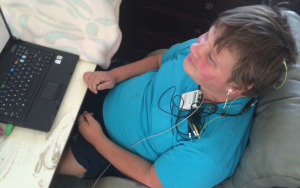
Just what is Neurofeedback?
Neurofeedback is biofeedback for the brain. It is a brain training technique that presents the trainee with real time brain-wave activity information. Also called neurotherapy, neurobiofeedback or EEG biofeedback the system reads and measures brain wave activity by utilizing sensors placed on the scalp, and amplifying the ‘sensed’ brain wave information onto a computer monitor. The trainee observes a video display accompanied by a “beep” or music. All of these game-like elements respond to shifts in the amplitude of the trainee’s various brain wave frequencies. The aim is to enable the client to gain conscious control of their brain-wave activity. If brain activity changes its amplitude in the direction desired by the therapist, a positive auditory reward in the form of a tone, or a visual reward, like seeing a ball move, is presented to the individual. If the brain wave activity regresses away from the goal, no feedback is given. Rewards can be as complex as controlling the hand movement in a video game character or as simple as a change in the pitch of a tone. This brain wave biofeedback experience can also be called operant conditioning for internal states.
Watch Lynette Louise aka THE BRAIN BROAD help Adam Gayner (former guitarist of Matchbox Twenty) calm his brain in this episode of Bravo’s Millionaire Matchmaker with Patti Stanger: Hooking Up The Brain to Calm Down
In the combining of EEG technology and Biofeedback principles a powerful tool has been created. Each of these two technologies which have been joined are powerful tools on their own; each with their own list of practical applications. EEG is used to view the brain and its reactions to different stimuli or tasks. It is also used to diagnose abnormalities within the brain. While Biofeedback is used as a mirror for self-reflection; and so, self-empowerment. Standard biofeedback works with symptomatic areas of a disorder and allows one to teach oneself alleviate those symptoms. The quantum leap of neurofeedback is that, by using an EEG as its information source, NFB allows one to view not the symptom but the underlying cause of a problem~ AND CHANGE THAT.
There are many theories leading to a variety of different brain-wave optimization goals being proposed by different researchers in the field of neurofeedback. Generally, these goals aim to normalize brain wave distribution and are based upon research comparing abnormal EEG patterns to normative data. Often a quantitative EEG (QEEG – also known as brain mapping) is the preferred method of assessment. The most common and well-documented use of neurofeedback is in the treatment of attention deficit hyperactivity disorder. This is because multiple studies over many years have shown neurofeedback to be effective in the treatment of ADHD (Butnik, 2005; Masterpasqual & Healy, 2003). Interestingly, a historically popular neurofeedback goal is the increase of activity in the 12–18 Hz band (beta1/SMR (sensorimotor rhythm)) and a decrease in the 4–8 Hz and/or 22–28 Hz bands (theta and/or beta2). The positive anecdotal reports of this common protocol has likely lead to some of the discoveries surrounding ADHD as evidenced by brain maps: QEEG has shown that ADHD is often characterized by an abundance of slow brainwaves and a diminished quantity of fast wave activity (Butnik, 2005).
Other areas where neurofeedback has been researched include treatment of substance abuse, anxiety, depression, epilepsy, TBI and more.
The international docu-series FIX IT IN FIVE with LYNETTE LOUISE aka THE BRAIN BROAD shows neurofeedback in use with families around the world. This is the most fun way to truly understand the concept, and value, of bio-feedback for the brain.
FIX IT IN FIVE with LYNETTE LOUISE aka THE BRAIN BROAD: Season 1, Eps. 1 from Lynette Louise on Vimeo.
For more information on neurofeedback and its applications you can visit these links:
http://en.wikipedia.org/wiki/Neurofeedback